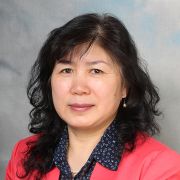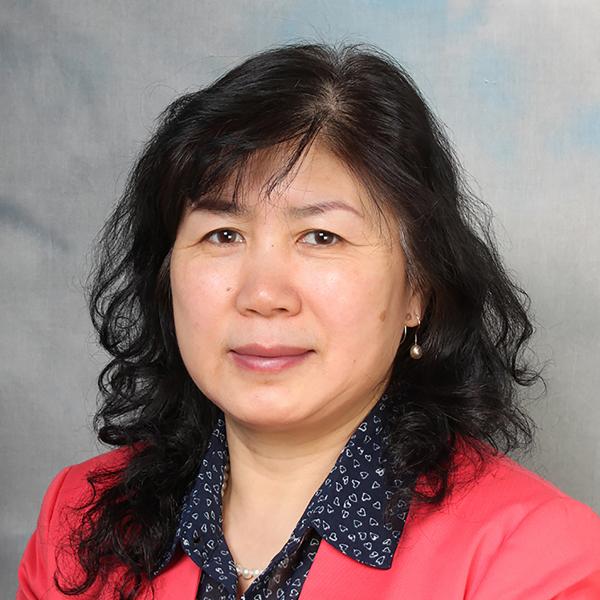Prof. Beining Chen
School of Mathematical and Physical Sciences
Professor of Medicinal Chemistry


+44 114 222 9467
Full contact details
School of Mathematical and Physical Sciences
Dainton Building
13 Brook Hill
Sheffield
S3 7HF
- Profile
-
After a BSc (1984) and MSc (1987) in China, Prof Chen obtained a PhD in Chemistry from the University of Glasgow in 1991. Subsequently, she became a Research Fellow at the Dyson-Perrins Laboratory in Oxford (1993-1995), after which she became a Research Fellow and then Lecturer at the University of Cranfield (1996-2002). In 2002 she became a Lecturer at the University of Sheffield, where she was promoted to Professor in 2014.
- Research interests
-
The major focus of our research is to use computer aided molecular design and combinatorial chemistry to facilitate drug design and molecular recognition studies.
Therapeutics
TSEs, are progressive, invariably fatal neurological disorders occurring in sheep, cattle and humans, and in a variety of other ungulates, felines and rodents. The disease involves the formation of pathological deposits of protein in the brain. The protein responsible, the non-infectious cellular isoform of prion protein (PrPC), can adopt an aberrant insoluble infectious conformation (PrPRes), which accumulates extracellularly and is resistant to denaturation and digestion with protease. Aggregation of PrPRes leads to neural disorder and thereafter the death of animals and humans affected. The development of therapeutic compounds has always been considered as one of the most important and challenge areas to be tackled in TSE research. The project aims to develop drugs which interacts with the biosynthetic pathway of prion protein either to stabilise its conformation or to provoke the interaction of the protein with its abnormal counterpart.
Our main focus now is to develop novel drugs for prion disease to cure Transmissible Spongiform Encephalopathies (TSEs) including Scrapie in Sheep, BSE in cattles and CJD in humans. Novel ideas together with a well written proposal have recently secured her group major funding from the Department of Health worth over £1.15 million. We are also building up our research in natural product chemistry/bioorganic chemistry for lead discovery. Activities in therapeutics are expanding into other amyloid diseases as well as areas cardiovascular, CNS, anti-viruses.
Proteomics - Structural Studies of Abnormal Prion Proteins
With very few exceptions, all cells in the human body contain the same genes. We need to know what proteins are produced and are active in different cells and at different times, because it is the proteins that make things happen. For example, they govern how cells communicate with each other to mobilise an immune response, or to detect and respond to changes in their environment. The genome is a parts list and the proteome (the complement of proteins) is an activity report. Proteomics is about understanding the function of proteins, both individually and collectively.
The most challenging area in the study of TSE is to understand how abnormal prion protein forms, and its structure and functions. Modern available technologies such as x-ray crystallography and NMR prove to be little use in studying the abnormal prion conformation due to the special insoluble properties of the plaque formed during protein aggregation. Theoretical modelling using molecular dynamics and bioinformatics as tools together with various labelling techniques are being developed in Prof. Chen's group for the prediction of abnormal prion structures.
- Publications
-
Journal articles
- . Molecular Informatics, 41(4).
- . Phytomedicine, 91, 153696-153696.
- . Chemical Science, 12(10), 3768-3785.
- . Journal of Medicinal Chemistry, 63(20), 11663-11690.
- . Journal of Computer-Aided Molecular Design, 34(7), 783-803.
- . Russian Journal of General Chemistry, 89(12), 2562-2570.
- . Journal of Chemical Information and Modeling, 59(10), 4167-4187.
- . Pure and Applied Chemistry, 91(7), 1107-1136.
- . Journal of Cheminformatics, 10.
- . New Phytologist, 218(3), 1205-1216.
- . Thrombosis and Haemostasis, 116(1), 96-102.
- . Neuro-Oncology, 17(suppl 8), viii20.1-viii20.
- . ChemInform, 46(16).
- . The Journal of Organic Chemistry, 79(21), 10196-10202.
- . Nat Chem Biol, 10(6), 450-456.
- . Curr Top Med Chem, 13(19), 2441-2464.
- . Bioorganic and Medicinal Chemistry Letters.
- Deconvolution of molecular targets for small molecule anti-prion compounds using proteomic and microarray techniques. PRION, 7, 66-66.
- . Stem Cells, 30(6), 1134-1143.
- . ChemMedChem, 7(4), 578-586.
- Indole-3-glyoxylamides as a novel lead series against prion diseases. PRION, 6, 99-99.
- Deconvoluting molecular targets for small molecule anti-prion compounds using proteomic and microarray techniques. PRION, 6, 98-98.
- , 29-43.
- . Bioorg Med Chem Lett, 21(12), 3644-3647.
- . Eur J Med Chem, 46(9), 4125-4132.
- . ChemMedChem, 6(1), 115-130.
- . J Pharm Biomed Anal, 52(5), 802-808.
- . ChemMedChem, 5(9), 1406.
- . MOL INFORM, 29(6-7), 533-541.
- . ChemMedChem, 5(9), 1476-1488.
- . J Chem Inf Model, 50(6), 1012-1020.
- . Methods Mol Biol, 627, 147-155.
- . ChemInform, 41(5).
- . ChemInform, 41(5).
- . J Med Chem, 52(23), 7503-7511.
- . ChemInform, 40(40).
- . J Org Chem, 74(18), 7084-7093.
- . J Org Chem, 74(18), 6999-7006.
- . J Chem Inf Model, 49(5), 1163-1184.
- . J Cheminform, 1(1), 5.
- . J Org Chem, 74(10), 3856-3865.
- . SYNLETT(20), 3183-3187.
- . ChemInform, 39(49).
- . TETRAHEDRON LETT, 49(36), 5324-5327.
- . Eur J Med Chem, 43(1), 93-106.
- . TETRAHEDRON, 63(24), 5300-5311.
- . J Med Chem, 50(6), 1347-1353.
- . J Comput Aided Mol Des, 21(1-3), 53-62.
- . ChemInform, 37(43).
- . ChemInform, 37(29).
- . Eur J Med Chem, 41(10), 1124-1143.
- . Tetrahedron, 62(24), 5617-5625.
- . TETRAHEDRON LETT, 47(14), 2361-2364.
- . J Chem Inf Model, 46(2), 478-486.
- . J Chem Inf Model, 46(2), 686-698.
- . J Med Chem, 49(2), 607-615.
- . J Pharm Biomed Anal, 40(4), 822-832.
- . Journal of Molecular Modeling, 11(6), 468-473.
- . MOL SIMULAT, 31(8), 597-604.
- . J Chem Inf Model, 45(4), 1061-1074.
- . Bioelectrochemistry, 67(2), 163-169.
- Prion therapeutics from traditional Chinese herbs. MOLECULAR & CELLULAR PROTEOMICS, 3(10), S45-S45.
- Prostate-specific antigen (PSA)-mediated proliferation, androgenic regulation and inhibitory effects of LY312340 in HOS-TE85 (TE85) human osteosarcoma cells. Anticancer Research, 22(5), 2725-2732.
- . Combinatorial Chemistry & High Throughput Screening, 5(6), 409-427.
- . Analytical Chemistry, 74(6), 1288-1293.
- . Journal of Medicinal Chemistry, 44(10), 1491-1508.
- . Analytical Chemistry, 72(18), 4381-4385.
- . Advanced Materials, 12(10), 722-724.
- . Clinical Chemistry, 45(9), 1596-1601.
- . Biosensors and Bioelectronics, 13(7-8), 779-785.
- . ChemInform, 28(46).
- . Bioorganic & Medicinal Chemistry Letters, 7(13), 1689-1694.
- . ChemInform, 27(36).
- . Journal of the Chemical Society, Perkin Transactions 1(11), 1153-1153.
Book chapters
- Thiazoles, Comprehensive Heterocyclic Chemistry III (pp. 635-754).
- , Comprehensive Heterocyclic Chemistry III (pp. 635-754). Elsevier
Conference proceedings
- Anti prion molecules and their interaction with amyloid β. PRION, Vol. 7 (pp 77-77)
- De novo design of synthetically accessible compounds: Application to fragment-based drug design. ABSTRACTS OF PAPERS OF THE AMERICAN CHEMICAL SOCIETY, Vol. 243
- Searching putative targets in silico for anti-prion compounds. ABSTRACTS OF PAPERS OF THE AMERICAN CHEMICAL SOCIETY, Vol. 243
- . ANALYTICAL LETTERS, Vol. 39(8) (pp 1627-1642)
- . Sensors and Microsystems (pp 88-94)
- . BIOSENSORS & BIOELECTRONICS, Vol. 20(6) (pp 1203-1210)
- . Biosensors and Bioelectronics, Vol. 16(9-12) (pp 631-637)
- . Journal of Pediatric Surgery, Vol. 35(1) (pp 139-143)
- Teaching interests
-
Medicinal Chemistry; Biological Chemistry.
- Teaching activities
-
Undergraduate and postgraduate taught modules
- Chemistry and the World Around Us (Level 1): Healthy Eating: Nutrients and Nutraceuticals
Introducing some simple chemical principles of familiar aspects of the world around us which we often take for granted and to highlight the significance of chemistry to everyday life, society, and the future of our planet. - Introduction to Chemical Biology & Medicinal Chemistry (Level 3)
This course explores the chemical biology behind proteins, and how they can be targeted in the development of new medicinal drugs. - Medicinal Chemistry (Year 4)
This segment introduces the main concepts, methods and limitations of the technique of modelling molecules using empirical (classical) descriptions of the interactions between atoms, functional groups and other properties of molecular fragments.
Support Teaching:
- Tutorials: Level 1 General Chemistry
- Level 3 Literature Review
Laboratory Teaching:
- Level 2 Organic Laboratories
- Level 3 Organic Laboratories
- Level 4 Research Project
- Chemistry and the World Around Us (Level 1): Healthy Eating: Nutrients and Nutraceuticals
